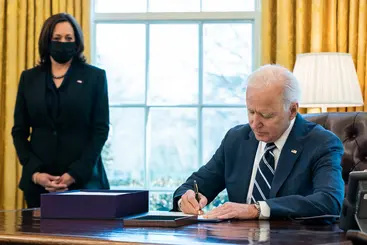The state of South Dakota is experiencing a transformative period in its water infrastructure, driven by a significant federal initiative. Recently, Hunter Roberts, the head of the South Dakota Department of Agriculture and Natural Resources, acknowledged an unexpected source of these advancements—the American Rescue Plan Act (ARPA), a law enacted by the Biden administration.

South Dakota Department of Agriculture and Natural Resources
Roberts, who was appointed by then-Governor Kristi Noem in 2019, initially expressed skepticism toward what he described as “overly broad, overreaching, unfounded laws and regulations” from Washington D.C. Despite these reservations, the federal funds provided under ARPA have had a deep impact on South Dakota’s water systems. The legislation, signed into law by President Joe Biden in March 2021, allocated a staggering $1.9 trillion to stimulate the national economy amid the COVID-19 pandemic.
South Dakota received approximately $1 billion of this funding, of which $689 million was channeled into 200 water-related projects throughout the state. These projects encompassed the construction and modernization of crucial infrastructure elements such as storage reservoirs, tanks, water pipes, treatment plants, and sewer lines. “It created an opportunity to make that investment and, I think, move our state forward long-term when we look at water-wastewater infrastructure, which is critical,” Roberts emphasized. “If we don’t have safe, clean drinking water, what else do we have?”
This influx of resources has led to what Roberts terms a “water renaissance” in South Dakota. The funding has propelled both small local systems and larger municipalities toward vital modernizations that may otherwise have remained stagnant for decades. While some systems had already begun upgrading prior to the ARPA funding, others were galvanized into action by the financial boost.

American Rescue Plan Act
Roberts presented these details during a recent legislative committee meeting at the Capitol in Pierre, highlighting not only the advancements in water infrastructure but also the broader impacts of ARPA funding. Beyond water and wastewater, the funds facilitated broadband internet expansion, housing infrastructure, telemedicine initiatives, and the construction of a new state public health laboratory.
Despite his praise for the ARPA’s positive outcomes in South Dakota, Roberts remains wary of the broader federal regulatory framework imposed during the Biden administration. His concerns resonate with the state’s traditionally conservative stance, particularly about potential regulatory overreach and its implications on economic sectors like agriculture.
The critical role of agriculture in South Dakota’s economy cannot be overstated, with vast plains stretching over miles, supporting both crops and livestock. The state has benefited from robust international trade agreements, which could face challenges under Trump’s tariff policies—a concern Roberts acknowledges. He notes, “That remains to be seen how that all works through the system, but it’s certainly something we’re watching closely.”
Looking forward, South Dakota stands at a decisive point regarding its development strategy. As the end of the current federal administration approaches, state leaders will need to navigate both the opportunities presented by past investments and the uncertainties of future policy directions. The ongoing dialogue within South Dakota underscores the delicate balance of federal support and state autonomy.
As South Dakota continues to progress, its water infrastructure renaissance stands as a testament to the state’s resilience and adaptability in the face of changing political landscapes. The dedication to ensuring safe drinking water reflects not only a commitment to health and well-being but also a strategic vision to bolster the state’s infrastructure for generations to come.